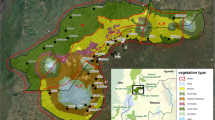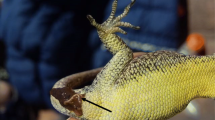Abstract
Dixenous helminths that depend on rodent intermediate hosts are supposed to be negatively affected by urbanization due to lower supply of rodents in urbanized environments. Prevalence rates of dixenous, non-strictly monoxenous, and monoxenous helminths in 228 red foxes (Vulpes vulpes) along a gradient of increasing urbanization were assessed by morphological parasite identification in the city of Geneva, Switzerland. Multivariate analyses for the five most prevalent helminth species or genera revealed a significant decrease of prevalence rates for the dixenous helminths Echinococcus multilocularis and Taenia spp. from the rural (52.1 and 54.3%, respectively) to the urban area (30.0 and 20.0%, respectively), but not for the monoxenous nematode Uncinaria stenocephala (overall prevalence of 78.2%) and the non-strictly monoxenous nematode Toxocara canis (overall prevalence of 44.3%). The lower prevalence of Toxascaris leonina in the urban area (8.0%) compared to the rural area (59.6%) raises the question of whether rodent paratenic hosts play a major role for the population dynamics of this species.


Similar content being viewed by others
References
Arneberg P, Skorping A, Grenfell B, Read AF (1998) Host densities as determinants of abundance in parasite communities. Proc R Soc Lond B 265:1283–1289
Artois M, Stahl P, Leger F, Morvan P, Barbillon E (1989) Prédation des rongeurs par le renard roux (Vulpes vulpes) en Lorraine. Gibier Faune Sauvage 6:279–294
Burke TM, Roberson EL (1985a) Prenatal and lactational transmission of Toxocara canis and Ancylostoma caninum. Experimental infection of the bitch before pregnancy. Int J Parasitol 15:71–75
Burke TM, Roberson EL (1985b) Prenatal and lactational transmission of Toxocara canis and Ancylostoma caninum. Experimental infection of the bitch at mid-pregnancy and at parturition. Int J Parasitol 15:485–490
Clopper CJ, Pearson ES (1934) The use of confidence or fiducial limits illustrated in the case of the binomial. Biometrika 26:404–413
Contesse P, Hegglin D, Gloor S, Bontadina F, Deplazes P (2004) The diet of urban foxes (Vulpes vulpes) and the availability of anthropogenic food in the city of Zürich, Switzerland. Mamm Biol 69:81–95
Criado-Fornelio A, Gutierrez-Garcia L, Rodriguez-Caabeiro F, Reus-Garcia E, Roldan-Soriano MA, Diaz-Sanchez MA (2000) A parasitological survey of wild red foxes (Vulpes vulpes) from the province of Guadalajara, Spain. Vet Parasitol 92:245–251
Deplazes P, Hegglin D, Gloor S, Romig T (2004) Wilderness in the city: the urbanization of Echinococcus multilocularis. Trends Parasitol 20:77–84
Despommier D (2003) Toxocariasis: clinical aspects, epidemiology, medical ecology and molecular aspects. Clin Microbiol Rev 16:265–272
Doncaster CP, Dickman CR, MacDonald DW (1990) Feeding ecology of red foxes (Vulpes vulpes) in the city of Oxford, England. J Mammal 71:188–194
Eckert J, Deplazes P (2004) Biological, epidemiological, and clinical aspects of Echinococcosis, a zoonosis of increasing concern. Clin Microbiol Rev 17:107–135
Epe C, Meuwissen M, Stoye M, Schnieder T (1999) Transmission trials, ITS2–PCR and RAPD–PCR show identity of Toxocara canis isolates from red fox and dog. Vet Parasitol 84:101–112
Ferrari N, Weber JM (1995) Influence of the abundance of food resources on the feeding habits of the red fox, Vulpes vulpes, in western Switzerland. J Zool London 236:117–129
Fischer C, Reperant LA, Weber JM, Hegglin D, Deplazes P (2005) Echinococcus multilocularis infections of rural, residential and urban red foxes (Vulpes vulpes) in the canton of Geneva, Switzerland. Parasite 12:339–346
Giacometti A, Cirioni O, Fortuna M, Osimati P, Antonicelli L, Del Prete MS, Riva A, D’Errico MM, Petrelli E, Scalise G (2000) Environmental and serological evidence for the presence of toxocariasis in the urban area of Ancona, Italy. Eur J Epidemiol 16:1023–1026
Gloor S, Bontadina F, Hegglin D, Deplazes P, Breitenmoser U (2001) The rise of urban fox population in Switzerland. Mamm Biol 66:155–164
Gortazar C, Villafuerte R, Lucientes J, Fernandez-de-Luco D (1998) Habitat related differences in helminth parasites of red foxes in the Ebro Valley. Vet Parasitol 80:75–81
Habluetzel A, Traldi G, Ruggieri S, Attili AR, Scuppa P, Marchetti R, Menghini G, Esposito F (2003) An estimation of Toxocara canis prevalence in dogs, environmental egg contamination and risk of human infection in the Marche region of Italy. Vet Parasitol 113:243–252
Harris S, Rayner JMV (1986) Urban fox (Vulpes vulpes) population estimates and habitat requirements in several British cities. J Anim Ecol 55:575–591
Hegglin D, Bontadina F, Contesse P, Gloor S, Deplazes P (2007) Plasticity of predation behaviour as a putative driving force for parasite life cycle dynamics: the case of urban foxes and Echinococcus multilocularis tapeworm. Funct Ecol (in press) DOI 10.111/j.1365-2435.2007.01257.x
Hofer S, Gloor S, Müller U, Mathis A, Hegglin D, Deplazes P (2000) High prevalence of Echinococcus multilocularis in urban red foxes (Vulpes vulpes) and voles (Arvicola terrestris) in the city of Zürich, Switzerland. Parasitology 120:135–142
Kappeler A (1991) Die orale Immunisierung von Füchsen gegen Tollwut in der Schweiz. Dissertation, University of Bern, Switzerland
Luty T (2001) Prevalence of species of Toxocara in dogs, cats and red foxes from the Poznan region, Poland. J Helminthol 75:153–156
Magnaval JF, Glickman LT, Dorchies P (1998) Toxocarose. In: Epidémiologie des Maladies Parasitaires, Tome 2, Helminthoses. Editions Médicales Internationales, Paris
Mizgajska H (1997) The role of some environmental factors in the contamination of soil with Toxocara spp. and other geohelminth eggs. Parasitol Int 46:67–72
Mizgajska H (2001) Eggs of Toxocara spp. in the environment and their public health implications. J Helminthol 75:147–151
Mozgovoi AA (1968) Ascaridata of animals and man and the diseases caused by them. Essentials of nematodology. Israel Program for Scientific Translations, Jerusalem
Overgaauw PA (1997) Aspects of Toxocara epidemiology: human toxocarosis. Crit Rev Microbiol 23:215–231
Richards DT, Lewis JW (2001) Fecundity and egg output by Toxocara canis in the red fox, Vulpes vulpes. J Helminthol 75:157–164
Richards DT, Harris S, Lewis JW (1993) Epidemiology of toxocara canis in red foxes (Vulpes vulpes) from urban areas of Bristol. Parasitology 107:167–173
Richards DT, Harris S, Lewis JW (1995) Epidemiological studies on intestinal helminth parasites of rural and urban red foxes (Vulpes vulpes) in the United Kingdom. Vet Parasitol 59:39–51
Saeed I, Taira K, Kapel CMO (2005) Toxocara canis in experimentally infected silver and arctic foxes. Parasitol Res 97:160–166
Saeed I, Maddox-Hyttel C, Monrad J, Kapel CMO (2006) Helminths of red foxes (Vulpes vulpes) in Denmark. Vet Parasitol 139:168–179
Smith GC, Gangadharan B, Taylor Z, Laurenson MK, Bradshaw H, Hide G, Hughes JM, Dinkel A, Romig T, Craig PS (2003) Prevalence of zoonotic important parasites in the red fox (Vulpes vulpes) in Great Britain. Vet Parasitol 118:133–142
Weber JM, Aubry S (1993) Predation by foxes, Vulpes vulpes, on the fossorial form of the water vole, Arvicola terrestris scherman, in western Sitzerland. J Zool (London) 229:553–559
Willingham AL, Ockens NW, Kapel CMO, Monrad J (1996) A helminthological survey of wild red foxes (Vulpes vulpes) from the metropolitan area of Copenhagen. J Helminthol 70:259–263
Acknowledgment
The study was funded by the Swiss Federal Office for Education and Science (EU FAIR Projekt CT97-3515/BBW no. 97.0586) and the European Commission (Project Echinorisk, contract QLK2-CT-2001-01995/BBW no. 00.0586-2). This publication represents part of the dissertation of Leslie Reperant, veterinarian.
Author information
Authors and Affiliations
Corresponding author
Rights and permissions
About this article
Cite this article
Reperant, L.A., Hegglin, D., Fischer, C. et al. Influence of urbanization on the epidemiology of intestinal helminths of the red fox (Vulpes vulpes) in Geneva, Switzerland. Parasitol Res 101, 605–611 (2007). https://doi.org/10.1007/s00436-007-0520-0
Received:
Accepted:
Published:
Issue Date:
DOI: https://doi.org/10.1007/s00436-007-0520-0




